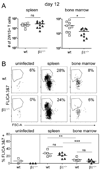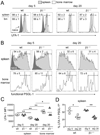β1 integrin is critical for the maintenance of antigen-specific CD4 T cells in the bone marrow but not long-term immunological memory
- PMID: 21357540
- PMCID: PMC3062718
- DOI: 10.4049/jimmunol.1003566
β1 integrin is critical for the maintenance of antigen-specific CD4 T cells in the bone marrow but not long-term immunological memory
Abstract
The long-term maintenance of memory CD4 T cells promotes protective immunity against future pathogen reinfection. As a site rich in survival cytokines, the bone marrow is proposed to be a critical niche for the survival of memory CD4 T cells. We demonstrate that endogenous, polyclonal Ag-specific CD4 T cells rapidly enter and are recovered long-term from the bone marrow following i.v. infection with Listeria monocytogenes. β(1) integrin-deficient CD4 T cells also populate the bone marrow early following an infection, but their numbers in this site rapidly decline. This decline was not caused by increased death of T cells lacking β(1) integrin but rather by reduced retention in the bone marrow after the primary immune response. The loss of memory CD4 T cells from the bone marrow does not lead to a loss of the predominant source of memory CD4 T cells in the spleen or the ability to mount a memory response. Thus, β(1) integrin-dependent maintenance of memory CD4 T cells in the bone marrow is not required for long-term CD4 T cell memory.
Figures






Similar articles
-
Constitutive expression of IL-7 receptor alpha does not support increased expansion or prevent contraction of antigen-specific CD4 or CD8 T cells following Listeria monocytogenes infection.J Immunol. 2008 Mar 1;180(5):2855-62. doi: 10.4049/jimmunol.180.5.2855. J Immunol. 2008. PMID: 18292507
-
Control of alpha4beta7 integrin expression and CD4 T cell homing by the beta1 integrin subunit.J Immunol. 2010 Mar 1;184(5):2458-67. doi: 10.4049/jimmunol.0902407. Epub 2010 Jan 29. J Immunol. 2010. PMID: 20118278 Free PMC article.
-
A specific role for B cells in the generation of CD8 T cell memory by recombinant Listeria monocytogenes.J Immunol. 2003 Feb 1;170(3):1443-51. doi: 10.4049/jimmunol.170.3.1443. J Immunol. 2003. PMID: 12538706
-
Homeostatic division is not necessary for antigen-specific CD4+ memory T cell persistence.J Immunol. 2012 Oct 1;189(7):3378-85. doi: 10.4049/jimmunol.1201583. Epub 2012 Sep 5. J Immunol. 2012. PMID: 22956580 Free PMC article.
-
Human T Cell Memory: A Dynamic View.Vaccines (Basel). 2017 Feb 4;5(1):5. doi: 10.3390/vaccines5010005. Vaccines (Basel). 2017. PMID: 28165397 Free PMC article. Review.
Cited by
-
Signals controlling rest and reactivation of T helper memory lymphocytes in bone marrow.Cell Mol Life Sci. 2012 May;69(10):1609-13. doi: 10.1007/s00018-012-0969-6. Epub 2012 Mar 30. Cell Mol Life Sci. 2012. PMID: 22460581 Free PMC article. Review.
-
Coordinated changes in DNA methylation in antigen-specific memory CD4 T cells.J Immunol. 2013 Apr 15;190(8):4076-91. doi: 10.4049/jimmunol.1202267. Epub 2013 Mar 18. J Immunol. 2013. PMID: 23509353 Free PMC article.
-
Single-cell characterization and quantification of translation-competent viral reservoirs in treated and untreated HIV infection.PLoS Pathog. 2019 Feb 27;15(2):e1007619. doi: 10.1371/journal.ppat.1007619. eCollection 2019 Feb. PLoS Pathog. 2019. PMID: 30811499 Free PMC article.
-
Novel Drug Targets in Diastolic Heart Disease.Int J Mol Sci. 2025 Aug 20;26(16):8055. doi: 10.3390/ijms26168055. Int J Mol Sci. 2025. PMID: 40869375 Free PMC article. Review.
-
Immunological memories of the bone marrow.Immunol Rev. 2018 May;283(1):86-98. doi: 10.1111/imr.12656. Immunol Rev. 2018. PMID: 29664564 Free PMC article. Review.
References
-
- Reinhardt RL, Khoruts A, Merica R, Zell T, Jenkins MK. Visualizing the generation of memory CD4 T cells in the whole body. Nature. 2001;410:101–105. - PubMed
-
- Masopust D, Vezys V, Marzo AL, Lefrancois L. Preferential localization of effector memory cells in nonlymphoid tissue. Science. 2001;291:2413–2417. - PubMed
-
- Di Rosa F. T-lymphocyte interaction with stromal, bone and hematopoietic cells in the bone marrow. Immunol. Cell Biol. 2009;87:20–29. - PubMed
-
- Benner R, Meima F, van der Meulen GM. Antibody formation in mouse bone marrow. II. Evidence for a memory-dependent phenomenon. Cell. Immunol. 1974;13:95–106. - PubMed
-
- Price PW, Cerny J. Characterization of CD4+ T cells in mouse bone marrow. I. Increased activated/memory phenotype and altered TCR Vβ repertoire. Eur. J. Immunol. 1999;29:1051–1056. - PubMed
Publication types
MeSH terms
Substances
Grants and funding
LinkOut - more resources
Full Text Sources
Molecular Biology Databases
Research Materials

